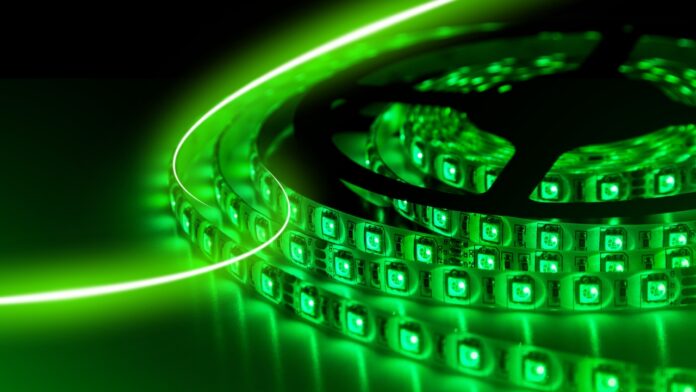There are many different types of light bulbs on the market these days, from traditional incandescent to more modern LED. While they all have their benefits, some people may find that their LED lights only emit green light.
So what’s the reason for this and is there anything that can be done about it? In this blog post, we’ll take a look at Why Are My Led Lights Only Green and what can be done to fix the problem. Stay tuned!
So, Why Are My Led Lights Only Green:
The main reason for only the green color on led lights issue is the fact that most LED lights are only able to produce one color of light. This is because.
1. The Type Of Diode Used:
Different types of diodes will emit different colors of light. For example, green diodes are typically made from gallium arsenide, while red diodes are usually made from aluminum gallium arsenide.
2. The Current Used:
The amount of current that is passed through the diode will also affect the color of the light. Higher currents will result in brighter and more saturated colors, while lower currents will produce dimmer and more muted hues.
3. The Temperature:
The temperature of the diode will also play a role in the color of the light. typically, higher temperatures will result in brighter colors, while lower temperatures will produce dimmer hues.
4. The Type Of Lens:
The lens that is used to focus the light can also affect the color. For example, a green lens will produce a green light, while a red lens will produce a red light.
5. The Type Of Material:
The material that the diode is made from will also affect the color of the light. For example, diodes made from gallium arsenide will typically emit green light, while those made from aluminum gallium arsenide will emit red light.
6. The Age Of Diode:
As diodes age, they can change color. This is due to the fact that the materials used to make them can degrade over time. For example, a green diode may turn yellow after years of use.
7. The Manufacturing Process:
The way that the diode is manufactured can also affect the color of the light. For example, diodes that are made using the MOCVD process will typically emit green light, while those made using the MBE process will emit red light.
8. The Wavelength Of Light:
The wavelength of the light that is emitted by the diode will also affect the color. For example, the green light has a wavelength of around 550 nm, while red light has a wavelength of around 650 nm.
9. The Level Of Doping:
The level of doping in the diode will also affect the color of the light. For example, a diode with a high level of doping will emit more blue light, while a diode with a low level of doping will emit more red light.
10. The Type Of Surface On The Diode:
The surface of the diode can also affect the color of the light. For example, a rough surface will scatter more blue light, while a smooth surface will scatter more red light.
How To Fix Led Lights With Only Green Color:
If you’re not happy with the green color of your LED lights, there are a few things you can do to fix the problem.
1. Try Using A Different Light Bulb:
While most LED lights will only emit green light, there are some that are designed to produce multiple colors. These bulbs typically use multiple diodes to create different hues, so they may be a better option for you.
2. Use A Color Filter:
This is an easy and inexpensive way to change the green color of your LED lights. All you need is a piece of colored cellophane or other translucent material. Cut it into a small square and tape it over the top of the light. This will change the color of the light that passes through it, giving you a different hue.
3. Change The Diode:
If you’re comfortable with a soldering iron, you can try changing the diode in your LED light. This will require you to open up the light and find the correct diode. Once you’ve done that, you can simply swap it out for a different color.
4. Paint The Light:
If you want a more permanent solution, you can try painting the light. This will require you to disassemble the light and remove the lens. Once that’s done, you can paint the light any color you want. Just be sure to use paint that is designed for use on plastics.
Conclusion:
LED lights are often marketed as being more environmentally friendly and cost-effective than other light sources. However, there have been some concerns about the health effects of LED lighting.
In this post, we’ve looked at the science behind these concerns and tried to provide some answers to why your led lights might only be green. If you still have questions after reading this post, please leave a comment below or contact us directly. We’d love to hear from you!
FAQs:
1. Why are my red led light green?
It’s possible that you are seeing the green color of the light because your eyes have not fully adjusted to the darkness. When someone first enters a dark room, their eyes may take several minutes to adjust and be able to see colors properly in the absence of light.
2. Are the LED lights supposed to be green?
Answer: No, LED lights are typically supposed to be green. This is because green LEDs emit more visible light than other colors, making them ideal for use in lamps and other lighting applications. However, some people may prefer the look of different colors.
3. Why are my led lights flickering?
Answer: LED lights usually flicker when they’re dimmed down to a low power setting. This is because they use a technology called pulse-width modulation (PWM) to control the amount of light that’s emitted from the bulb. When PWM is used to dim an LED, it causes the light to flicker.




